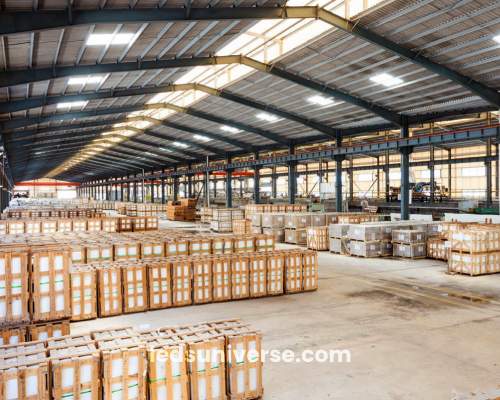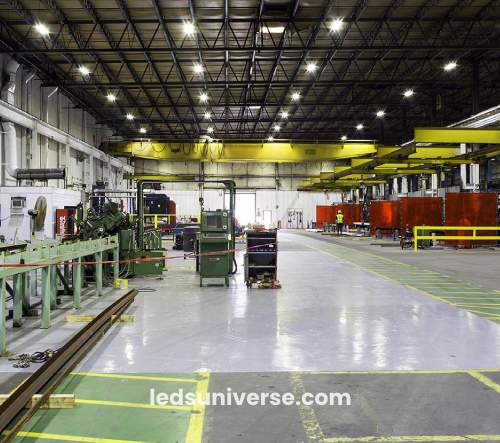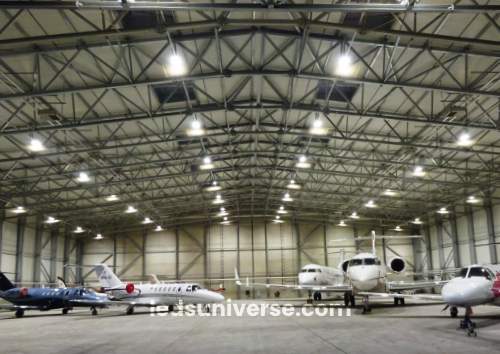High bay lighting brings bright, efficient illumination to vast spaces like warehouses, factories, and gyms, where standard lighting can’t keep up. These powerful fixtures provide the perfect mix of clarity and coverage, turning dim, hard-to-light areas into vibrant, productive spaces. Whether you’re lighting up a busy industrial floor or creating the right atmosphere in a gym, high bay lighting makes a noticeable difference in both energy savings and performance.
High bay lighting is designed for illuminating large spaces with high ceilings, typically ranging from 15 to 40 feet. This type of lighting is primarily used in industrial and commercial environments, such as warehouses, factories, gymnasiums, and large retail stores, where bright, evenly distributed light is crucial for operational efficiency and safety. High bay lighting systems are designed to provide sufficient illumination at elevated heights, ensuring that the light reaches the floor and covers a wide area.
In this page, we will explore the various types of high bay lighting, their features, benefits, design considerations, and installation processes, along with a discussion on the latest trends and standards that affect the industry.
Reach out for free lighting consultation
Table of Contents
ToggleThe market offers several types of high bay lighting, each with unique advantages and drawbacks. The type of lighting chosen depends on factors like energy efficiency, upfront cost, maintenance, and the specific needs of the space being lit.

LED (Light Emitting Diode) high bay lights have become the go-to option in recent years due to their energy efficiency and long lifespan. LEDs consume significantly less energy compared to traditional lighting systems, such as metal halide or fluorescent lights, while providing bright, consistent illumination. One of the key advantages of LED lighting is its ability to produce high lumens per watt, meaning that it generates more light using less power.
In addition to energy savings, LEDs last much longer than other lighting types, often up to 50,000 to 100,000 hours, which reduces maintenance and replacement costs. LED high bay lights are also environmentally friendly, as they contain no harmful materials like mercury, and their lower energy consumption results in reduced greenhouse gas emissions.
Fluorescent high bay lights, especially T5 and T8 fluorescent tubes, were once popular for large spaces due to their affordability and availability. These lights are more energy-efficient than older incandescent bulbs but not as efficient as LEDs. Fluorescent lighting provides a decent color rendering index (CRI) and uniform light distribution. However, fluorescent bulbs have shorter lifespans compared to LEDs and require more frequent replacement, which can increase maintenance costs over time.
One drawback of fluorescent high bay lights is their sensitivity to temperature fluctuations. In very cold or hot environments, their performance can degrade, leading to flickering or reduced brightness.
Metal halide (MH) lamps have been a traditional choice for high bay lighting due to their ability to produce high-intensity light with good color rendering. These lights are commonly used in industrial and outdoor applications where bright, white light is needed. However, metal halide lights consume a lot of energy, produce a significant amount of heat, and have relatively short lifespans, typically around 10,000 to 20,000 hours.
Moreover, metal halide lamps take time to reach their full brightness after being switched on, and frequent switching can reduce their lifespan. These inefficiencies, combined with the rise of LED technology, have led to a decline in the use of metal halide lights in favor of more energy-efficient solutions.
Induction lighting is less commonly used but offers unique advantages, such as a long lifespan and high energy efficiency. These lights work by using electromagnetic fields to generate light, eliminating the need for filaments or electrodes. Induction lights can last up to 100,000 hours, making them a low-maintenance option. However, their high upfront cost and limited availability make them less popular than LEDs.
When selecting a high bay lighting system, several important features need to be considered. These features impact the quality of light, energy consumption, and overall effectiveness of the lighting in large spaces.

The brightness of a high bay light is measured in lumens, not watts. Lumens indicate how much light a fixture emits, and the amount required depends on the size and use of the space. For example, a warehouse or factory may require high lumen output to ensure visibility and safety, while a gymnasium might need moderate brightness to avoid glare.
In general, the larger the space and the higher the ceiling, the more lumens are needed. LED high bay lights typically offer higher lumens per watt compared to other lighting types, making them more efficient in large spaces.
| Type of Space | Recommended Lux Level (lux) | Description |
|---|---|---|
| General Storage Areas | 100–200 lux | Suitable for areas where minimal visual accuracy is required. |
| Packing and Sorting Areas | 200–300 lux | For tasks that require moderate visual clarity and attention. |
| Assembly or Production Areas | 300–500 lux | Essential for spaces where detailed work is carried out. |
| Gymnasiums or Sports Facilities | 300–500 lux | Ensures proper visibility for athletes and spectators alike. |
| Retail Spaces with High Ceilings | 500–800 lux | For spaces where product visibility and customer experience are key. |
| Inspection/Quality Control Areas | 500–1000 lux | Ensures accuracy and detail for quality inspection processes. |
For spaces such as warehouses, which are primarily used for storage and general operations, lux levels between 100 and 200 lux are sufficient. This range allows for clear visibility while optimizing energy consumption. Lighting fixtures for such spaces should be mounted strategically to ensure light is distributed evenly, with minimal shadows or dark spots.
In areas where more detailed tasks are performed, such as in assembly lines or quality control stations, the required lux level can be significantly higher, ranging from 300 to 500 lux. Bright and uniform lighting in these areas helps reduce errors, improves productivity, and ensures the safety of workers.
In spaces like gymnasiums or sports arenas, where lighting must ensure visibility for both players and spectators, lux levels should range from 300 to 500 lux. Bright, evenly spread light helps athletes perform better and reduces the risk of injury.
The beam angle of a high bay light refers to the spread of light emitted from the fixture. Narrow beam angles (e.g., 60 degrees) focus the light in a specific area, making them suitable for tall ceilings and concentrated tasks. Wide beam angles (e.g., 120 degrees) provide broader light coverage and are better for evenly illuminating large areas with lower ceilings.
Choosing the correct beam angle is important for ensuring that the light is evenly distributed without creating dark spots or areas with excessive brightness.
High bay lighting is typically mounted at heights ranging from 15 to 40 feet. The higher the ceiling, the more powerful the lighting needs to be to ensure that the light reaches the floor evenly. At greater heights, narrow beam angles may be more effective, while wider angles are better suited for lower mounting points.
Proper mounting height and spacing between fixtures are essential for ensuring that the light covers the entire area without overlapping or leaving shadows.
Color temperature, measured in Kelvin (K), describes the hue of the light emitted by a fixture. High bay lights are available in various color temperatures, ranging from warm to cool.
| Color Temperature | Range (Kelvin) | Description |
|---|---|---|
| Warm White | 3000K–4000K | Provides a softer, warmer light. Suitable for spaces that benefit from a more relaxed ambiance, such as retail stores or gymnasiums. |
| Cool White/Daylight | 5000K–6000K | Offers a bright, crisp light that closely resembles natural daylight. Ideal for industrial environments like factories or warehouses where clear visibility and high productivity are crucial. |
High bay lighting fixtures are often constructed from durable materials like aluminum or polycarbonate to withstand the rigors of industrial and commercial environments. These materials are resistant to impacts, dust, and moisture, making them ideal for harsh conditions, such as manufacturing plants or outdoor storage areas.
LED high bay lights, in particular, are known for their robust construction, which reduces the need for frequent maintenance and repairs.
High bay lighting offers numerous benefits for businesses, ranging from energy efficiency to improved safety and productivity.

One of the most significant advantages of modern high bay lighting, particularly LED systems, is energy efficiency. LED high bay lights consume up to 80% less energy than traditional lighting solutions like metal halide or incandescent lamps. This not only reduces electricity bills but also contributes to a lower carbon footprint, making high bay lighting an environmentally friendly choice.
The energy savings from LED high bay lights can result in significant cost reductions, especially in large industrial spaces that require lighting 24/7.
Proper lighting is essential for ensuring safety in large industrial spaces. High bay lighting provides bright, even illumination, reducing the risk of accidents caused by poor visibility. In environments like warehouses or manufacturing plants, where heavy machinery and vehicles are used, clear lighting helps employees navigate the space safely.
Additionally, LED high bay lights are designed to minimize glare and flickering, which can reduce eye strain and improve overall safety in the workplace.
Good lighting is directly linked to employee productivity. In workspaces where visibility is crucial, such as assembly lines or warehouses, high bay lighting ensures that workers can perform their tasks with accuracy and efficiency. Studies have shown that well-lit environments improve concentration, reduce fatigue, and boost morale, ultimately leading to higher productivity levels.
Choosing the right color temperature and ensuring uniform light distribution can further enhance worker comfort and efficiency.
High bay lighting is versatile and can be used in a variety of settings, both indoor and outdoor. Whether it’s a gymnasium, factory floor, or large retail store, high bay lights can be tailored to meet specific lighting needs. They are also available with features like dimming, motion sensors, and smart controls, which allow businesses to customize their lighting systems for optimal performance and energy savings.
When planning a high bay lighting system, it’s important to consider several design factors that can impact the effectiveness and efficiency of the lighting.

Factors like ceiling height, room dimensions, and obstructions such as shelving units or machinery must be taken into account to ensure that the light reaches all areas evenly. In a warehouse, for example, lights may need to be spaced more closely together in areas with high racks to prevent shadowing.
Modern high bay lighting systems can be integrated with smart lighting controls, such as motion sensors, dimmers, and timers. These controls help optimize energy usage by ensuring that lights are only on when needed. For instance, motion sensors can detect when a space is occupied and turn the lights on automatically, while dimmers allow for adjusting light levels based on the task at hand.
Smart lighting systems can also be programmed to reduce energy consumption during non-peak hours, further enhancing efficiency.
Poorly distributed light can lead to eye strain, reduced productivity, and safety hazards. To achieve uniformity, lighting designers must carefully calculate the placement, mounting height, and beam angles of the high bay lights.
In some cases, reflectors or diffusers can be used to spread light more evenly across the space.
Glare can be a significant issue in large spaces with high-intensity lighting. Excessive glare can cause discomfort, reduce visibility, and lead to accidents in industrial settings. To reduce glare, high bay lights can be equipped with anti-glare lenses or shields that diffuse the light, creating a softer and more pleasant lighting environment.
Proper installation and maintenance are key to maximizing the performance and lifespan of high bay lighting systems.
High bay lights must be installed at the correct height and spacing to ensure optimal light distribution. While some smaller spaces may allow for DIY installation, it’s generally recommended to hire professional electricians for large commercial or industrial installations. Professional installers will ensure that the lights are mounted securely, wired correctly, and positioned to provide even illumination throughout the space.
Safety precautions are essential during installation, especially when working at heights, and all installations should comply with local electrical codes and safety standards.
The maintenance of high bay lighting systems varies depending on the type of lights used. LED high bay lights require minimal maintenance due to their long lifespan and durability. However, occasional cleaning of the fixtures is necessary to remove dust and debris, which can accumulate over time and reduce light output.
Other types of high bay lights, such as metal halide or fluorescent, require more frequent bulb replacements and maintenance checks, which can increase the long-term costs of the lighting system.
Many businesses are opting to retrofit their existing high bay lighting systems with energy-efficient LED fixtures. Retrofitting involves replacing outdated lights with new LED lights while keeping the existing wiring and fixtures in place. This process can significantly reduce energy consumption and improve lighting quality without the need for a complete overhaul of the lighting system.
Upgrading to LED high bay lights also opens the door to incorporating advanced features like smart lighting controls, further enhancing efficiency and functionality.
High bay lighting systems must comply with various standards and regulations that govern energy efficiency, safety, and environmental impact.
Several organizations set energy efficiency standards for lighting systems, including the U.S. Department of Energy (DOE) and the Environmental Protection Agency (EPA). Certifications such as Energy Star or LEED (Leadership in Energy and Environmental Design) indicate that a lighting system meets high standards for energy efficiency and environmental sustainability.
Choosing high bay lighting fixtures that are certified by these organizations can help businesses reduce energy costs and contribute to sustainability goals.
The Occupational Safety and Health Administration (OSHA) sets requirements for workplace lighting to ensure that employees have adequate visibility in their work environments. High bay lighting systems used in industrial or commercial spaces must meet OSHA’s standards for minimum illumination levels, glare reduction, and overall lighting quality.
Failure to comply with these standards can result in fines and penalties, as well as increased safety risks in the workplace.
Proper disposal of lighting materials is essential to minimize environmental harm. Fluorescent and metal halide lights contain hazardous materials, such as mercury, that must be disposed of in accordance with environmental regulations. LED lights, on the other hand, contain fewer harmful materials and are easier to recycle.
Many countries have regulations in place to promote the recycling of lighting fixtures and prevent hazardous waste from entering landfills.
When selecting a high bay lighting system, we may consider factors like light output, beam angles, color temperature, and durability to ensure the best possible performance. Additionally, staying informed about energy efficiency standards and safety regulations can help businesses make responsible choices that benefit both their operations and the environment.